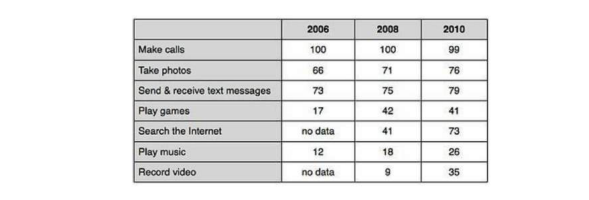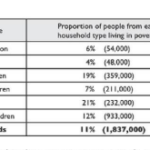The table compares the percentages of people using different functions of their mobile
phones between 2006 and 2010.
Throughout the period shown, the main reason why people used their mobile phones was to
make calls. However, there was a marked increase in the popularity of other mobile phone
features, particularly the Internet search feature.
In 2006, 100% of mobile phone owners used their phones to make calls, while the next
most popular functions were text messaging (73%) and taking photos (66%). By contrast,
less than 20% of owners played games or music on their phones, and there were no figures
for users doing Internet searches or recording video.
Over the following 4 years, there was relatively little change in the figures for the top three
mobile phone features. However, the percentage of people using their phones to access the
Internet jumped to 41% in 2008 and then to 73% in 2010. There was also a significant rise
in the use of mobiles to play games and to record video, with figures reaching 41% and
35% respectively in 2010.
(178 words)
Estimated IELTS Band Score: 7.5 – 8.0
- Task Achievement (7.5):
Describes the main features well and makes comparisons. Could add a bit more detail in some areas. - Coherence & Cohesion (8.0):
Logically structured with clear topic sentences and transitions. - Lexical Resource (7.5):
Uses a good range of vocabulary but could incorporate more varied synonyms. - Grammar & Accuracy (7.5):
Mostly accurate, with minor potential improvements in complex sentence structures.
Band 8
The table shows the proportion of mobile phone owners using various features in 2006, 2008, and 2010. Overall, making calls remained the most common function throughout the period, while searching the internet and recording video became significantly more popular.
In 2006, 100% of users made calls, while the next most popular features were sending and receiving text messages (73%) and taking photos (66%). Only 17% played games, and just 12% played music. No data were recorded for internet searches or video recording in 2006.
By 2010, using the phone to make calls had dropped slightly to 99%. Texting and taking photos saw moderate increases, rising to 79% and 76%, respectively. Meanwhile, the percentage of users searching the internet grew markedly from 41% in 2008 to 73% in 2010. Playing games climbed to 41% and playing music to 26%, while recording video rose to 35%.
These trends indicate that while traditional functions like calls and text messages remained prevalent, more advanced features, especially internet searches and video recording, experienced notable growth.
Word Count: 167
Band 9
The table compares the percentages of mobile phone users engaging in different activities across three years: 2006, 2008, and 2010. Overall, making calls remained the dominant function, while internet searches and video recording emerged as rapidly growing features.
In 2006, every mobile owner (100%) used their device for calls, followed by texting (73%) and taking photos (66%). Less than a fifth of users played games (17%) or music (12%), and there were no figures for internet searches or recording videos at that time.
By 2008, internet use appeared for the first time at 41%, then surged to 73% by 2010. The proportion of users recording videos rose from 9% in 2008 to 35% in 2010. Gaming also saw a substantial increase, from 17% in 2006 to 42% in 2008, settling at 41% in 2010. Meanwhile, making calls dipped marginally to 99% by 2010, and both texting and photo-taking saw modest increases, reaching 79% and 76%, respectively.
In summary, while core functions like calls and messaging remained highly utilized, advanced functionalities such as internet searches and video recording gained significant traction over the four-year span.
Word Count: 185
Comparison Table
| Aspect | Band 7-8 Version | Band 9 Version |
|---|---|---|
| Vocabulary | Clear and straightforward (“notable growth,” “moderate increases”) | More precise (“dominant function,” “rapidly growing features,” “surged”) |
| Sentence Structure | Mostly direct with some complex sentences | More varied and complex structures, smoother transitions |
| Data Presentation | Covers key numbers and comparisons well | Provides sharper contrasts and year-to-year changes clearly |
| Clarity & Cohesion | Well-structured, logical flow | More refined transitions and concise concluding statements |
Examples from Essays
| Aspect | Band 7-8 Example | Band 9 Example |
|---|---|---|
| Sentence Structure | “By 2010, using the phone to make calls had dropped slightly to 99%.” | “Meanwhile, making calls dipped marginally to 99% by 2010.” |
| Data Presentation | “The percentage of users searching the internet grew markedly from 41% in 2008 to 73% in 2010.” | “By 2008, internet use appeared for the first time at 41%, then surged to 73% by 2010.” |
| Clarity & Cohesion | “These trends indicate that while traditional functions remained prevalent, more advanced features experienced notable growth.” | “In summary, while core functions like calls and messaging remained highly utilized, advanced functionalities such as internet searches and video recording gained significant traction.” |
Grammar Mistakes
- Original: “In 2006, 100% of mobile phone owners used there phones to make calls.”
Correction: “In 2006, 100% of mobile phone owners used their phones to make calls.” (Fixed possessive pronoun error.) - Original: “By 2008, Internet usage was 41% before it jumped to 73% in 2010.”
Correction: “By 2008, internet usage had reached 41% before jumping to 73% in 2010.” (Improved verb tense and flow.) - Original: “Meanwhile, the use of mobiles to record video also increased from no data in 2006 to 9% in 2008 and 35% in 2010.”
Correction: “Meanwhile, mobile video recording, which had no data reported in 2006, rose to 9% in 2008 and 35% by 2010.” (More natural phrasing.)
Vocabulary Repetition
| Repeated Word | Suggested Alternatives |
|---|---|
| “Increase” | Rise, Surge, Climb, Growth |
| “Use/Using” | Utilize, Employ, Engage in |
| “Features” | Functions, Capabilities, Options |
IELTS Writing Task 1 Exercises with Answers
Fill in the blanks using the words below:
(dominant, surged, prevalent, modest, emerging, proportion)
- The table compares the _______ of mobile phone users who employed various functions in 2006, 2008, and 2010.
Answer: proportion - Making calls remained the _______ feature, with 100% of users in 2006 and only a slight dip to 99% in 2010.
Answer: dominant - Internet searches were an _______ function in 2008 at 41%, but they _______ to 73% by 2010.
Answer: emerging, surged - Texting and photo-taking both saw _______ increases, remaining _______ at around 70-80% by 2010.
Answer: modest, prevalent

